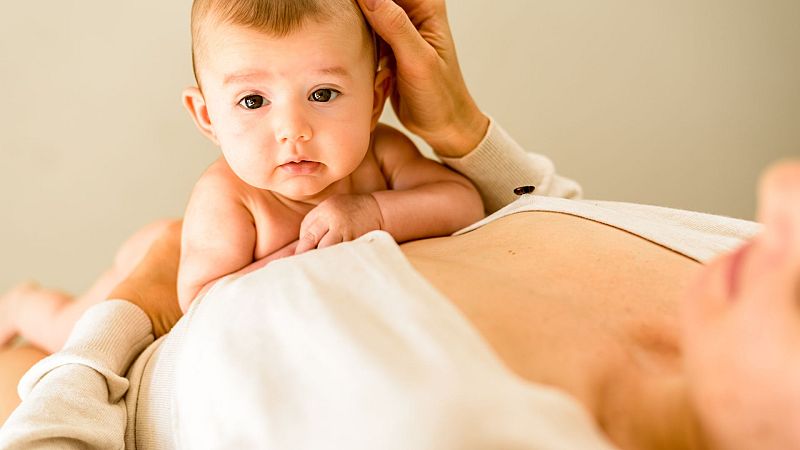Swedish doctors warn parents about hormone treatments after a baby girl grows a ‘micropenis’

At least a dozen children in Sweden have developed unexpected physical changes after being accidentally exposed to hormone gels and sprays in recent years, health officials told Euronews Health.
In one case, a ten-month-old girl in Sweden developed an enlarged clitoris that resembled a small penis after lying on the chest of her father, who was using a testosterone gel.
In another case, a 10-year-old boy began growing breasts after exposure to his mother’s hormone treatment.
These cases have been reported by clinicians at Sahlgrenska University Hospital in Gothenburg, Sweden, who are warning parents who use topical hormone medications to avoid direct contact after applying their treatments.
Hormone medications contain sex hormones that our bodies start to produce at puberty.
Topical treatments, such as gels, creams, and sprays, are prescribed to adults with hormone-related disorders, patients who have finished chemotherapy, and others.
But there’s a risk, the Swedish doctors said, that children can absorb the hormones through skin-to-skin contact with adults using these treatments, leading to medical complications like those reported in Gothenburg.
“Babies younger than 12 months of age have very absorbent skin,” Dr Jovanna Dahlgren, a chief physician in the department of Paediatrics at Sahlgrenska University Hospital, told Euronews Health.
She added that “we should spare the kids” from accidental exposure to highly potent sex hormones.
There are other options for parents who take hormone medications. Dahlgren recommends quarterly injections for patients taking testosterone, whilst patches and vaginal tablets could be an alternative to oestrogen sprays.
She also said parents can apply topical treatments to areas unlikely to come into contact with children, such as the inner thighs or upper back, and recommended people keep them in a safe area away from their child’s reach.
Lack of awareness despite the increasing number of cases
Doctors at the Sahlgrenska University Hospital started seeing cases of hormone exposure in children around eight or nine years ago, according to Dahlgren.
Endocrinologists there raised the issue with regional authorities, leading to new medical guidelines, and with a pharmaceutical company that made hormone treatments, which updated its warning labels.
The growing popularity of online prescriptions may be contributing to the rise in cases, Dahlgren said.
In some European countries, including Sweden, Germany, and France, telehealth platforms can legally prescribe hormones.
According to Sweden’s Medical Products Agency, Läkemedelsverket, there have been 12 reports of “unintended hormone exposure affecting children” since 2019. Another two cases were reported to the European medicines regulator.
But Dahlgren believes this represents only a fraction of actual toll, as those do not include any of the cases recorded at her hospital.
“Our own cases aren’t represented in those numbers,” she said, “so the real figure is certainly higher”.
The hospital is now collaborating with other regional centres to map the extent of these cases nationally.
The problem isn’t isolated to Sweden
In 2024, paediatric endocrinologists in Wales published a case series documenting children who developed early pubertal signs after exposure to hormone gels or sprays used by parents.
The study included similar cases as those seen in Sweden, as well as a case of a girl with breast development and mood swings linked to her mother’s use of oestrogen gel.
The researchers also emphasised the mental health impact that unexpected hormone exposure can have on both children and their parents, who often feel guilty.
Earlier this year, a Swedish trade magazine for medical professionals reported that globally there were 41 reports of suspected secondary exposure in children and adults involving oestrogen-containing medications between 2018 and 2025, and 66 reports linked to testosterone-containing products between 2004 and 2025.
Follow-up care varies depending on the severity and duration of exposure.
For example, the infant girl with clitoris enlargement in Sweden recovered fully after the exposure ended.
However, some young patients with repeated exposure for a long period of time need to be followed until they are adults, Dahlgren said.
For instance, the 10-year-old boy with unusual breast growth is now awaiting breast reduction surgery, and his bone growth could also be disrupted due to accelerated bone age.
“We have to think about the long-term effects,” Dahlgren said.
These hormones “are steroids and act directly on the DNA, changing protein expression across the body”.
She cautions that long-term exposure to testosterone can increase risks of blood clots, heart attack, stroke, and even cancer in adults. In children, the damage can be lifelong.
“That's why I would urge that people are aware that these hormone medications are potent,” Dahlgren said.
Today

